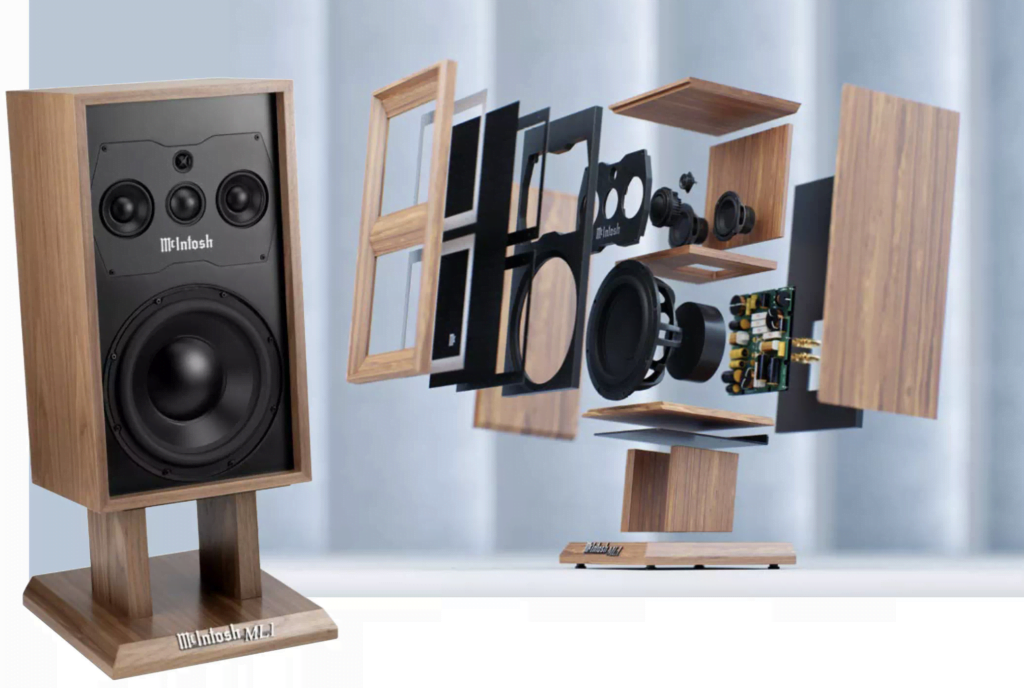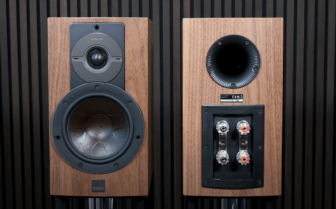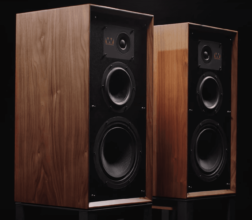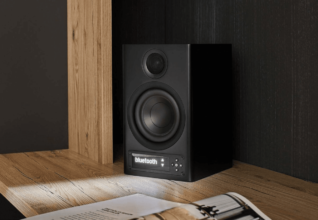MCINTOSH ML1 MK II Loudspeaker review
Forget the snazzy retro design; these MCINTOSH ML1 MK II don’t sound like speakers from the ’70s at all. Tested at 6000$ each.
That’s probably a good thing. Who wants a speaker from the ’70s? Except for purely nostalgic reasons, of course.
Back then, speakers were nowhere near what you find in stores today. Simple – not to say primitive – crossovers, drivers with cones too large for the voice coils and magnets, and completely lacking the materials and technology we now take for granted.
If you find a pair of working ’70s speakers, you’ll likely find they sound charming and perhaps not too bad considering their age, but that’s about it.
DESIGN AND FUNCTIONALITY
But if you ignore the design, retro is as popular as ever, especially with speakers. Brands like Klipsch, JBL, Sonus faber, and many others design speakers with a classic look but use modern materials.

That’s why speakers like the Klipsch Heritage series (see Klipsch Heritage Speakers at Amazon) or JBL L100 Classic can play with dynamics, balance, and resolution that barely existed in the ’70s. 7Review tested some Klipsch Heritage speakers: Klipsch ProMedia Heritage 2.1, KLIPSCH HERESY IV.
McIntosh’s retro speakers do the same thing. They look decidedly retro, with a design that hasn’t aged a bit since 1970 when McIntosh launched the original ML1 in American walnut. A two-way speaker that was in production until 1977.
According to Ken Kessler’s book For the Love of Music, which chronicles McIntosh’s history since 1949, the idea for a better speaker came from Gordon Gow. At McIntosh, there was frustration that speakers of the time were rarely good enough to reveal differences in sound between various components.
Speakers back then had double-digit distortion, increasing even more when the volume was turned up. Gow tasked Roger Russell and Sidney Corderman with solving this in 1967. Three years later, the ML-1C was ready. There was also an equalizer – the MQ101 – which could be added to adjust the speakers’ sound to the room.
MARK II
There was never a Mark II or any new versions of the ML1. Until now. The new ML1 MK II has largely retained the original American walnut design. Solid wood, not veneer, and a removable American walnut grille almost identical to the original.
The original was a four-way floor speaker with a 12-inch woofer, an 8-inch mid-bass, a 1.5-inch upper midrange/tweeter, and a 0.75-inch tweeter.
A fairly advanced design for its time, which according to Roger Russell, had a frequency range of 20 Hz to 20,000 Hz. Incredible at the time for a speaker meant for a private home. Specifications that made a subwoofer unnecessary.
The new ML-1 doesn’t need a sub either. While it doesn’t go quite as deep, reaching 27 Hz, it goes much higher at the other end, up to 45 kHz according to McIntosh.
They achieved this with a four-way design, a sealed cabinet, and no EQ. This alone is quite remarkable. Especially considering the cabinet size is only 66 cm, plus stands specifically designed for the speakers.
DUAL CHAMBERS
The design is unusual nowadays. Most opt for a ported cabinet, either with a bass reflex port or a transmission line, to increase bass efficiency. McIntosh has not focused on efficiency. At least not sensitivity, which is 85 dB. Low for such a complex design and a clear indication that you actually need the power a McIntosh amplifier can provide.
The 12-inch woofer with a rigid polypropylene cone is mounted with a synthetic rubber surround. The woofer sits in its own sealed chamber, taking up half the volume of the well-made cabinet.
FOUR-WAY
The signal is split at 180 Hz to the drivers in the speaker’s upper chamber, also sealed. Two 10 cm midrange drivers, also with polypropylene cones and rubber surrounds, are mounted horizontally. Between them sits a 50 mm midrange driver with a dome-shaped diaphragm covering 500 to 4,500 Hz. The upper frequencies are handled by the same 19 mm titanium dome tweeter we heard in the McIntosh XR100 and XR50.
The four drivers in the upper chamber are mounted on a sturdy milled metal baffle. The crossover is located in the lower chamber and connected to robust bi-wire terminals of the same type McIntosh uses on their amplifiers.
The stands, made specifically for the speakers, angle them backward and raise them to 92 cm, plus any spikes or damping feet.
AMPLIFIERS AND MORE
The first time I heard the McIntosh speakers, they were demonstrated with the McIntosh MC451. This is a hybrid mono power amplifier combining transistors with vacuum tubes, delivering 300 watts from the transistors and 150 watts from four KT88 tubes per channel. The speakers were driven by bi-amping, where the transistor section of the amplifier drove the bass and the tubes handled the rest.

Even though the demonstration was brief, it was remarkable how little distortion was part of the sound image when the volume was very high. There was absolutely nothing in the sound that could remind one of a speaker from the ’70s.
Nor was there later, when I could finally park the speakers and stands in my own listening room. They stayed there for several weeks, only being loaned out briefly, and during the weeks I had the speakers, they were the most used of all we had at our disposal.
With a good range of amplifiers, it quickly became clear that the speakers thrived best with the most potent ones. The Yamaha A-S3200 with 100 watts worked surprisingly well. It has plenty of torque and a powerful power supply, and it matched nicely with the energetic McIntosh speakers. They also worked well with McIntosh’s own MC275, a 75-watt tube amplifier that McIntosh actually recommends for the ML1 MKII. From experience, I would consider stepping up to an MC312 or MC462, which have almost endless power, at least if you want to fill a very large room with loud sound.
PUNK HAIRSTYLE AND SILK TIE
I didn’t need that, and the MC275 had more than enough power to raise the sound pressure in the room. I missed a bit of the bass control that an MC462 would have provided at high volume, but tubes or transistors don’t dictate the speakers’ qualities. The warm sound from the tube amplifier also removed some of the harshness in the treble, which could occasionally occur if I played very loudly.
I don’t know if it’s due to diffraction from the edges around the recessed front plate. But it was at least masked with the grilles on. They stick to the edges with magnets, and with the grilles on, the sound doesn’t change significantly. Perhaps it becomes slightly muted with drum brushes on the snare, but it doesn’t affect vocals or piano.
On the delightful The Elder with the Jan Gunnar Hoff ensemble, recorded in Sofienberg Church in Oslo, the piano is warm and well-defined, even in the large church. And the atmosphere is more noticeable than on the recording Morten Lindberg made in 2017. The speakers present the music in the room where the recording was made, and the dynamics are almost explosive. On the next track, Revamp, it feels like Audun Kleive’s percussion is about to leap out of the speakers. Such dynamism is rarely heard from a speaker of this size.
I can play as loudly as I dare. The speakers remain unwaveringly stable. The double bass is as tightly defined as when I play softly; the scale just becomes larger. At the same time, the soundstage is pleasantly warm without ever becoming muddy.
Not even on the razor-sharp Private Investigations by Dire Straits. An album track that begs to be played loudly. The guitar in the introduction is warmer than usual, but also fuller, with more resonance. The vocals are dry, almost a bit recessed, but my goodness, such dynamics. Percussion, and later drums, thunder out of the speakers with a speed and force I haven’t experienced since, for example, the Klipsch Cornwall IV and DALI Kore.
The speakers have an ability to handle and highlight details in the sound image, even the small ones. It’s noticeable, not just in Private Investigations but also in Leif Ove Andsnes’s interpretation of Chopin’s Impromptu No.1 in A major. The recording, made at Potton Hall in Suffolk, UK, can sound a bit dry and distant. Here, the music is brought closer, and there is a sea of tonal colors that other speakers in the same class often mask.
A style change to Miley Cyrus’s Flowers gave me the same energy from the speakers. The somewhat flatter dynamics are likely due to the recording, but the speakers clearly had their silk ties and dancing shoes on. It gets much tougher with Kvelertak’s Krøterveg Te Helvete, a fiery inferno of guitars and percussion – and lyrics that can scare anyone. Here, the speakers shone with playfulness even when I played loudly, something most speakers strongly dislike. Full control for almost eight minutes. A blast that can deafen anyone is no match for these speakers. They can truly do it all.
It’s not easy to find speakers from competitors that can do everything the ML1 can. The Sonus faber Maxima Amator, which we tested recently, is more refined but far less dynamic and can’t play as loudly. The KEF Reference 3 Meta doesn’t reach as deep in the bass, and the Audiovector R6 Arreté is too expensive to be in this company. Instead, thoughts turn to the JBL 4367, which has the same explosive dynamics, and in our opinion, is the closest you’ll get to a pair of McIntosh ML1.
ML1 MK II SPECS:
Type: Four-way stand-mount speaker
Woofer: 25 cm polypropylene
Midrange: 2 x 10 cm polypropylene + 5 cm dome
Tweeter: 19 mm titanium dome
Sensitivity: 85 dB
Impedance: 8 ohms
Frequency range: 27–45,000 Hz
Crossover frequencies: 180 Hz, 500 Hz, 4,500 Hz
Max power handling: 75–600 watts
Recommended amplifier power: Not specified
Dimensions/Weight: 66.4 x 38.1 x 34 cm/30 kg
Colors: American solid walnut with stand
Website: psaudio.dk
Verdict
They could have missed the mark entirely, but McIntosh has succeeded in renewing the ML1 while creating a speaker that can definitely challenge the best in its class. It plays louder and tougher than most, with steel-like control all the time. The bass reproduction is impressively deep and powerful, while McIntosh has managed to make the speakers both open and transparent. You might find yet another level of fine-tuned finesse elsewhere, but there are few speakers in this class that combine explosive dynamics with so much finesse and entertainment as the McIntosh ML1. If you like the retro design, it’s a no-brainer.
Powerful dynamics and genuine deep bass are combined with an airy and open soundstage. Can play louder and cleaner than you think – and dare.
Low sensitivity and sealed cabinet demand a lot from the amplifier. The design is not for everyone.
When you purchase through links on our site, I may earn an affiliate commission. Here’s how it works.
McIntosh ML1 MKII REVIEW
What you have been asking/waiting for!! Adrian is reviewing the McIntosh ML1 MKII in this video, comment down below what you ...










